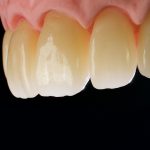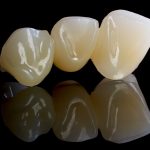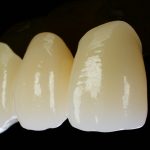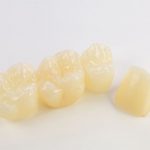For all open milling machines that accept round blanks with a diameter of 98.5 mm
priti®multibloc ZrO2 multicolor High Translucent is the material of choice for the most vibrant, highest aesthetics on restorations with up to three pontics.
(5Y-TZP) available in 7 color gradients and 1 bleach shade, 49% translucence, flexural strength > 650 MPa.
Adjusting the position in the same disc allows all 16 Vita shades to be achieved with just 7 blanks!
Indication
You can use priti®multidisc ZrO2 multicolor High Translucent to fabricate inlays, onlays, veneers, partial crowns, anatomically reduced and monolithic, fully anatomical crowns and bridges (up to three pontics) for anterior and posterior areas Translucence is comparable to that of lithium disilicate. Its high translucence and integrated color gradient mean the material is particularly suitable for efficient fabrication of non-veneered restorations.
MATERIAL
- Zirconium dioxide Type II, Class 4 (DIN EN ISO 6872)
- Flexural strength > 650 MPa
- High translucence of 49%
- Brilliant aesthetics
- CTE 10 ·10-6 · K-1
- Thin wall thicknesses of 0.4 mm for single crowns in the anterior tooth area and 0.6 mm in the posterior tooth area
- Precise edges and margins due to highly compacted material
- Veneering possible with any ceramic mapped to the CTE of ZrO2
- Cross-batch color fidelity
- Homogeneous block shading
- Color can be reproduced at any time
- Biocompatible
CHEMICAL COMPOSITION
Zirconium dioxide (ZrO2/HfO2): 89.89 - 90.7 %
Yttrium oxide (Y2O3): 8.55 - 10.11 %
Aluminum oxide (Al2O3): < 0.2 %
Other oxides: < 0.7 %
CONSTRUCTION
| Systems must be constructed of the following specifications: | Crowns | Maryland-bridges | 3-unit bridges | |
| Minimum framework thickness | anterior | 0.4 mm | 0.4 mm | 0.6 mm |
| Minimum framework thickness | posterior | 0.6 mm | 0.6 mm | 0.6 mm |
| Connectors | anterior | 6 mm² | 6 mm² | |
| Connectors | posterior | 9 mm² | 9 mm² | |
| Framework design | Anatomically shaped (supporting veneer ceramics); fully anatomical | |||
SINTERING
Recommendation for standard sintering:
Heating and cooling rate 10°C/min
Hold time 120 minutes at 1,450°C
Total sintering time approx. 7 hours
Recommendation on rapid sintering: (for bridges with up to 3 pontics)
Heating rate 10°C/min
Hold time 30 minutes at 1,500°C
Cooling rate 40°C/min
Total sintering time approx. 4 hours
Sintering together with other materials could cause unwanted changes in color and translucence. This applies particularly to materials processed using dye liquids. Sintering beads must also be replaced to avoid dye liquid residues.
It is particularly important to clean sintering furnaces that are contaminated by dye liquids before sintering a pre-shaded material for the first time. This prevents unpleasant surprises and allows optimum photo-optical results for the zirconium dioxide.
VENEERING
Any ceramic veneers recommended for zirconium dioxide ceramics may be used.
MILLING
Reduce feed rates during rough machining: The quality of milling depends on several factors including the machine, machining strategy, zirconium dioxide, etc. To ensure that you can achieve optimum milling results from the start with high translucence blanks, we recommend using a lower speed than with opaque materials during rough machining.
| Job | Rough machining Occlusal/cavity |
Rough machining Residual material |
|---|---|---|
| Tool diameter | 2.5 mm | 1.0 mm |
| Parameter: | ↓ | ↓ |
| Spindle speed | 20,000-22,000 rpm | 20,000-22,000 rpm |
| Feed rate | 1,200-1,500 mm/min | 1,000-1,300 mm/min |
| Infeed rate | 1,000 mm/min | 700 mm/min |
| Allowance | 0.15 mm | 0.15 mm |
| Tool path distance | 1.00 mm | 0.20 mm |
| Step down/step over | 1.00 mm | 0.50 mm |
Coated milling tools: These offer the benefit of low wear with longer tool life.
ADJUSTMENTS
Any adjustments required to the sintered restorations once compacted must only be carried out using diamond-coated tools to prevent damage to the material caused by local overheating or exposure of the surface of the restoration to excessive force.
FIXING
Restorations can be cemented conventionally with a zinc phosphate or glass ionomer cement or with self-adhesive and fully-adhesive fixing material.
COLOR-CODING
Through the measurement of the restoration height an even more precise positioning and color assignment can be made to the appropriate blank height. The positioning data apply mainly to anteriors. For posteriors we recommend a lower position. This prevents fused cusp areas appearing too white. An additional positive effect is the warm base hue due to the fissure pits.
| Restoration height | Blank height |
| 8 mm - 11 mm | 14 mm |
| 10 mm - 13,5 mm | 18 mm |
| 12 mm - 15,5 mm | 20 mm |
| 14 mm - 19 mm | 25 mm |
| pritidenta® Shades |
Position | VITA classical® | VITA System 3D-Master® |
| top | A1 | 2M1, 1M2, 2R1,5 | |
| A light | middle | A2 | 2M2 |
| bottom | A3 | 3M2 | |
| top | A3,5 | 3R2,5 | |
| A dark | middle | ||
| bottom | A4 | 5M3, 4L2,5 | |
| top | B1 | ||
| B light | middle | ||
| bottom | B2 | 2L1,5 | |
| top | B3 | 3L2,5 | |
| B dark | middle | ||
| bottom | B4 | 3M3 | |
| top | C1 | 3M1 | |
| C light | middle | ||
| bottom | C2 | 3L1,5 | |
| top | C3 | ||
| C dark | middle | 4L1, 5E30 | |
| bottom | C4 | 5M1, 5M2 | |
| top | D2 | ||
| D light | middle | D3 | 4R1,5, 4R2,5 |
| bottom | D4 | 3R1,5, 4M1, 4M2, 4M3 | |
| top | 0M1,0M2 | ||
| priti® bleach | middle | 0M3 | |
| bottom | 1M1 |





